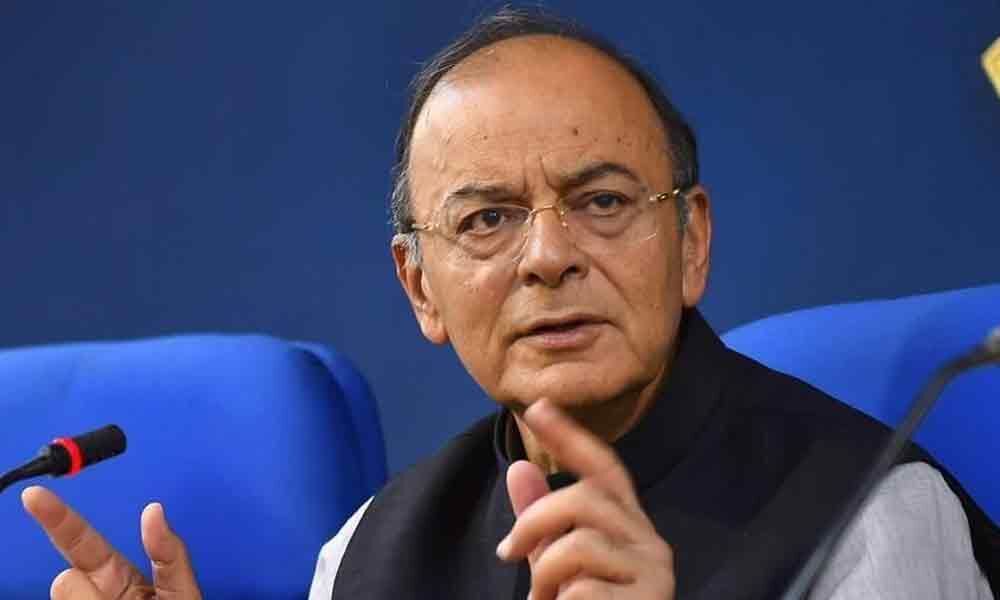Live
- HC quashes FIR against BJP MP over farmer suicide post
- Centre’s intent is to finish off small parties: DK Shivakumar
- Allu Arjun Released from Chanchalguda Jail, says he respects law
- Jesus is synonymous with sacrifice, forgiveness: Ponnam
- HC announces verdict in Kannada for the first time
- Uttam releases water from Nizam Sagar for Rabi crop
- TG to be Rs 84L cr economy in 10 years: Sridhar Babu
- First TGCHE, V-Cs meet deliberates on higher education roadmap for state
- 2 senior professors to join NALSAR
- Former Principal of SPW College passes away in US
Just In
Single rate GST not possible in India: Jaitley


A single rate under the Goods and Services Tax (GST) is not possible in a country like India where there is a large number of people below the poverty line
New Delhi: A single rate under the Goods and Services Tax (GST) is not possible in a country like India where there is a large number of people below the poverty line, former Union Finance Minister Arun Jaitley wrote in a blog post on the second anniversary of the new indirect tax on Monday.
"Those who argued for a single slab GST must realise that a single slab is possible only in extremely affluent countries where there are no poor people," Jaitley, who was the Finance Minister for the bulk of the first two years of the GST, wrote.
"It would be inequitable to apply a single rate in countries where there are a large number of people below the poverty line," he added.
Stating that 12 and 18 per cent tax slabs could be merged, thereby effectively making it a two-tier tax, Jaitley said as many as 20 states are already showing more than a 14 per cent increase in their revenues and do not require the Centre to compensate them for revenue loss arising out of GST implementation.
Jaitley, who in May wrote to Prime Minister Narendra Modi expressing his unwillingness to be a Minister in the Modi 2.0 government due to health reasons, said most items of consumer use have been brought in the 18 per cent, 12 per cent and even 5 per cent category.
The GST Council, chaired by the Union Finance Minister and comprising state Finance Ministers, has reduced tax rates over the last two years which led to revenue loss of more than Rs 90,000 crore, he said.
"Except on luxury and sin goods, the 28 per cent slab has almost been phased out. Zero and 5 per cent slabs will always remain. As revenue increases further, it will give an opportunity to policy makers to possibly merge the 12 per cent and 18 or cent slabs into one rate, thus, effectively making the GST a two-rate tax," he said.
Observing that a sudden reduction of tax rates on all categories of goods can lead to a massive loss of revenue for the government leaving it without resources to spend, Jaitley said "this exercise had to be done in a gradual manner as the revenues increased".
In the eight months of 2017-18 (July to March), the average revenue collected was Rs 89,700 crore per month. In the next year (2018-19), the monthly average has increased by about 10 per cent to Rs 97,100 crore.
"In the pre-GST regime, the rich and the poor, on various commodities, paid the same tax. The multiple slab system not only checked inflation, it also ensured that the Aam Aadmi products are not exorbitantly taxed. Illustratively, a hawai chappal and a Mercedes car cannot be taxed at the same rate.
This is not to suggest that the rationalisation of slabs is not needed. That process is already on," he said.

© 2024 Hyderabad Media House Limited/The Hans India. All rights reserved. Powered by hocalwire.com






